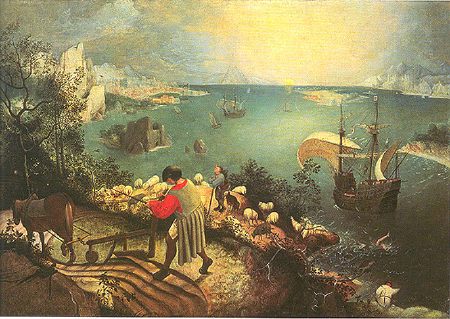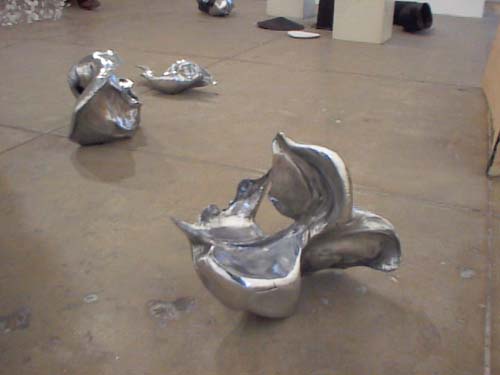ANNALS OF NATIONAL SECURITY/Seymour M. Hersh/ LUNCH WITH THE CHAIRMAN/ Why was Richard Perle meeting with Adnan Khashoggi?
[just found this on Google, and thought I’d add it to the NYMDb. Normally, I set the post date so the links appear in chronological order, but since this story is so timely, I’ll leave it on top for a few days. – greg]
Related:
Under Attack, Director Says Hollinger’s Black Misled Him [NYT]
Category: new yorker magazine database
…And I Feel Fine (Except For This Gnawing Sense Of Dread)
Yes, I was glad to see you, and that was a Bible in my pocket. As I tee up to write what appears below, I just realized my schedule yesterday (aka the Sabbath)–church in the morning to the Armory Show (similarities to Gilligan’s Island: began as 3-hour tour, saves self with pleasantly endless supply of special guest stars) to a friend’s dinner for a visiting artist–and my increasing revulsion at politicians’ Christian justification for war, left me toting the Good (but not tiny) Book around all day, and unselfconsciously reading on the train about “blessed are the peacemakers,” “wars and rumours of wars,” and the end of the world as we know it.
I remember being advised, soon after moving to NYC in 1990, that reading the NY Times or the WSJ on the train was a surefire invitation to be mugged. And The Wall St. Journal? Forget about it. The only way to protect yourself, I was told, is to be a less attractive target than other passengers: you can either talk loudly to yourself (i.e., act insane, and thus, unpredictable, possibly dangerous, not worth the hassle) or read the Bible. It’s the pickpocketing equivalent of The Club, self-centered public religiosity that really says, “mug my neighbor.” What would Jesus do, indeed.
WWJD? How about WWGWBD? Bob Woodward in Hendrik Hertzberg‘s New Yorker commentary: “‘[Bush’s] instincts are almost his second religion.’ And if the commandment of his first religion is peace, that of his second, it seems clearer than ever, is war.” Not so fast. Bush’s flavor of Christianity has little to do with the Bible (King James Study Bible , Amazon sales rank: 3,598), and everything to do with Left Behind (Armageddon: The Cosmic Battle of the Ages vol. 11, Amazon sales rank: 67).
With over 50 million copies in print, the Left Behind series is the Harry Potter of the Apocalypse, (If God doesn’t call the authors home soon, there’ll be 12 books total; never seen onr on the subway, though). It the end of the world as its authors (Tim Lahaye and Jerry Jenkins, evangelical ministers/ex-political aides/anointers of John Ashcroft) know it. After millions of True Believers are suddenly caught up in The Rapture, the world stops slouching toward Gomorrah and starts lurching toward Armageddon. Plagues and war ravage the unbelieving earth. After a feckless Democratic president sells the US out to international organizations (it’s not one of heaven’s mysteries that the series began during Clinton’s tenure), the Anti-Christ steps in, seduces shocked citizens with pleas of global tolerance, uses the UN to establish world government, and settles down to rule and reign. From Bahghdad. Oh, and before the world ends, Israel gets all the land it wants. Oh, and the Jews convert to Christianity, etc. etc.
Articles appeared last year (in Salon and the Guardian, for example) after Left Behind took over the NYTimes bestseller list, causing lamentation in the mainstream publishing houses, and Infidels.org (you have been warned) got ready for Y2K with a veritable Baskin-Robbins (31+ flavors) of End Time culture. But as Zachary Karabell writes in last week’s LA Times, “The response of some in the U.S. government to the crises of the last year and a half feels ripped from the pages of the Left Behind books.” If Bush were a straphanger, he’d be doubled down, flaunting the Bible and acting insane, thinking he’s safe (yet somehow unaware that all the other passengers are nervously switching cars).
Frankly, Left Behind strikes me as gratuitous vengeance porn, designed to feed the smugness and self-satisfaction of “Christian” readers, who want to have their cake (their own seat on the Rapture train) and eat it, too (the details of their critics’ impending, gruesome suffering). Is Bush taking his war script from the Gospel according to Left Behind? Is he gonna have a lot more to answer for than he thinks? Is the Pope Catholic?
On WTC Site Designs
What I hope doesn’t carry through from the plans the LMDC selected from Daniel Libeskind and THINK Team:
What I hope does carry through:
What Filler calls such a concept, which I personally favor: “unquestionably the most provocative.” [I think he’s talking about the latticework as Ban’s, not the memorial. I like both.]
Despite a lot of overwrought reaction, Filler wins the greg.org “smartest critic” award for agreeing with me on so many points: this memorial idea, the 1,776′ tower, and (finally!) the Eisenman-as-ruin-as-memorial-instigator analysis.
Can’t Wait To See It

Anthony Lane on Keith Fulton and Louis Pepe’s documentary, Lost in La Mancha: “For anyone who suffers from the wish to make movies, or who fears that this terrible condition may strike at any time, here is the cure.”
WTC Site Designs Revealed While Director Poaches Memorial-Friendly Media
[2018 UPDATE: In 2018 The New York Times reports that five women who worked with Meier, either at his firm or as a contractor, have come forward to say the architect made aggressive and unwanted sexual advances and propositions to them. The report also makes painfully clear that Meier’s behavior was widely known for a long time, and that his colleagues and partners did basically nothing to stop it beyond occasionally warning young employees to not find themselves alone with him. This update has been added to every post on greg.org pertaining to Meier or his work.]
If the 3+ hour multimedia press conference for around 25 brand name architects to present their proposals for the World Trade Center site were Saks, I was the chick selling hand-beaded mittens from a card table on the sidewalk. Actually, as a media event, it was more wholesale than retail; press and LMDC staffers outnumbered Invited Guests about 3:1. So rather than just spam the (presumably interested in memorials) crowd with cards for tomorrow’s screening, I switched to providing background and “context” to the media folks and sharing thoughtful opinions and quotes on the designs. (ex. “They sure don’t build ’em like they used to,” opined Greg Allen, a New York filmmaker whose documentary about a WWI memorial opens today at MoMA…”)
So, how are they? Well, compared to the first round of designs announced in July (which sucked), things are looking up. As one juror told me, the overall high quality of these designs just makes him realize how depressing last summer actually was, and I have to agree; some of the designs are quite impressive, inspiring, even. Here are some action photos from the event; It was a real scrum for a while.

WTC Bathtub wall under construction, 1968. Image: Museum of The City of New York
Daniel Libeskind‘s memorial proposal, titled Memory Foundation, includes the “bathtub” as well as the towers’ footprints. The bathtub–a watertight, concrete, underground structure designed to hold back the Hudson River–should be recognized as a symbol of strength and resilience, says Libeskind. The New Yorker re-published a fascinating 1972 account of the bathtub’s construction by Edith Iglauer.

Foster & Partners, “tallest, cleanest” etc.. Image: LMDC
Lord Foster’s presentation shows why he got the upgrade (from Norman and Sir, for that matter). He was smooth, his images were clear and seductive, and he dropped references to his work so lightly (“The Reichstag is a memorial itself, really…”), that selecting his two towers “which kiss and touch and become one” seemed inevitable.
In an unexpected train wreck of a presentation, the “Dream Team” (Richard Meier’s opening words), sought to shun ego and it’s evil progeny, “architecture.” At least they avoided the architecture. Meier’s unfortunately morose presentation matched the missed opportunities of their proposal.
I say missed, because in the most impressive presentation and proposal of them all, United Architects, another team effort, nailed the incredible potential of ideas the Dream Team had right in front of them. Even though it appeared in other proposals, too, UA made a Sky Memorial a reality by showing that it already exists; Greg Lynn talked of the team members’ early and overwhelming visits to the families’ viewing room, which overlooks Ground Zero. They proposed one memorial 60 stories in the air, atop the first building to be constructed at the perimeter of the site. Gradually, four more towers would join it, forming a “cathedral-like” arc around the memorial in the footprints.

United Architects, view of (1620′) towers from footprint memorial. Image: LMDC
The towers would angle toward each other across the restored street grid, forming a massive, new urban space, 60 stories up and five stories high, contiguous across all five towers. To drive their proposal home, they showed an extremely effective film, which alternated views from within the buildings with repeated shots of people on the street looking up, like they used to do. It was surprisingly impressive. See their flash presentation on their site.
As for me, well, I did a fair job of working the crowd, chatting up anyone I saw with a green sticker on (ie., media) and then handing out quotes, reactions, and the cards for tomorrow’s screening of Souvenir (November 2001). There were some very nice responses, and no one seemed to equate this kooky project with the scattering of amateur memorialists and professional World Trade Center groupies who crowded the periphery of the event. Combined with the encouraging replies from the mailings that went out, tomorrow could turn out alright.
About Schmidt: The Thinking Person’s “My Big, Fat Greek Wedding”
Nobody’s Perfect, indeed. If Anthony Lane can’t get beyond Jack’s celebrity, fine. He saw the movie at the NY Film Fest opening. His unabashed pinky-extended criticism almost always gives an enjoyable read. (Need some holiday cheer? Get his collected reviews, Nobody’s Perfect, today Don’t even think you can stuff a stocking with it or take it on a plane, though.)
But Salon’s review by Charles Taylor seems to be such a bitter, willful misread of the film, it defies explanation. So let me explain: Taylor actually misunderstands the audience, or more precisely, large swaths of the population of the US, including the hundreds of millions of excruciatingly normal people who fail to “delight (movie directors as) eccentrics and kooks and small-town oddballs” and who would never consider themselves “vulgar and naive and tacky,” just the opposite.
In About Schmidt as well as his previous films, Alexander Payne proves that excruciatingly normal doesn’t automatically mean boring. Just the opposite. In a long Times article, A. O. Scott tries to place Payne’s (and Nicholson’s) Schmidt in a grand tradition of the “mythic cinema hero, The Regular Guy.” This tradition extends from the creations of Clifford Odets, Sinclair Lewis, Arthur Miller, and John Updike to “just about every movie cop and sitcom dad.” (Sitcom. Remember sitcom.) Although Scott cites Jimmy Stewart and Fred “My Three Sons” MacMurray, the only actual movie he cites is Marty, which Delbert Mann had originally directed on television. Mythic, indeed.
Marty is the classic immigrant affirmation story, which won Oscars in 1955, for its star (Ernest Borgnine, nee Borgnino, an Italian), writer Paddy Chayefsky, a Jew from the Bronx) producer (Harold Hecht, a Jew from Poland), and director (Mann, from…Lawrenceville, Kansas). Beset by his loud Italian mother and family and feeling fat an unattractive, Marty falls for a teacher; the mismatched couple overcomes the family’s objections and their own insecurity on their way to their fairytale marriage. Sound familiar? It should, since it’s the same damn plot as My Big, Fat, Greek Wedding.
David Denby rightly called Greek Wedding on its big, fat sitcom roots, and the story of how its unexpected success among The Ignored caught Hollywood and the culture capitalists off guard is now accepted wisdom; Denby’s own New Yorker review didn’t even appear until September, six months after the film’s debut, and presumably, after Denby’s aunts and mother wouldn’t let him off the hook for ignoring it any longer. For The Ignored, it’s their own story, told in the style they were trained by television to expect. About Schmidt is a remarkable film about The Ignored that tells their own story in a powerful, serious way. It may never achieve the box office success of Greek Wedding, which is too bad. For the first time in fifty years, there’s actually a good film about a Mythic Cinema Hero.
Some Quotes and Links
“Asbury’s book is a tribute to the magical power of naming: long stretches of ‘Gangs [of New York]’ are taken up by lists of gangs and villains and even fire engines, and, like the lists of ships in the Iliad, they are essential to the effect…We read of Daybreak Boys, Buckoos, Hookers, Swamp Angels, Slaughter Housers, Short Tails, Patsy Conroys, and the Border Gang, of Chichesters, Roach Guards, Plug Uglies, and Shirt Tails, and we melt.”
— Adam Gopnik discussing Herbert Asbury’s cult-fave 1928 book in the New Yorker
“What you really are afraid of is that you’re competing against somebody who is rich and irrational. I mean, it used to be a given, a saying in the industry: Don’t ever bid against Rupert Murdoch for anything Rupert wants, because if you win you lose. You will have paid way too much.”
— media mogul John Malone, in an interview with Ken Auletta at NewYorker.com
“Just as Italians don’t translate Johnny Cash as ‘Giovanni Soldi,’ and we don’t take Federico Fellini and rename him ‘Freddy Cats,’ so the term Arte Povera has to stand unchanged and unexplained.”
— Blake Gopnik, brother, writing (entertainingly but incorrectly) about the Hirshhorn Gallery’s latest show in the Washington Post
“Then sometimes you’re given the chance to make a memory for someone, give them a pleasant moment to remember, which is the greatest thing you can ever do. Keep the Oscar and all that.”
— Rod Steiger, Oscar winner, on Jon Favreau’s Dinner for Five on IFC
“We’re a little tired of the thin-skinned whining, which is much of what we get from north of the border…
— Pat Buchanan, defending his comment about “Soviet Canuckistan” on the CBC’s As It Happens [Pat’s about 12:00 into the stream.]
Porn (‘n Chicken) on the Internet? What’ll they think of next?
James “Sweet Jimmy the Benevolent Pimp” Ponsoldt was a co-founder of Porn ‘n Chicken, a Yale timekiller-cum-media spoof-cum-Comedy Central movie. (If that sentence doesn’t get this weblog banned by your corporate firewall, it’ll at least get you a reprimand at your performance review.) Tad Friend’s New Yorker piece contains Jimmy’s description of his latest project:
“It’s ‘Long Day’s Journey Into Night’ set in rural Appalachia,” he said, “with themes of rifts between generations, loneliness, becoming a man, and OxyContin addiction.”
Sound familiar? It took me a second, but it’s Cyan Pictures’ Coming Down the Mountain. Despite what the title may lead you to believe, it has nothing to do with Porn or Chicken. [For fun, try and match the other porny aliases in the article with the crew at Cyan!}
carry-on luggage, four weeks later
Nearly a month after an accidental click into a carry-on luggage article brought my surfing to a teary halt, it’s okay to laugh again. In this week’s New Yorker, Nick Paumgarten tells of of several successful attempts to carry Emmy Award statuettes (complete with “sharp-tipped wings”…shaped like “serrated steak knives”) onto transatlantic flights. [Apparently, none of the comedy writers or filmmakers in the story are yet listed on Ashcroft’s dissenter=terrorist no-fly list or are giants of Iranian cinema.]
On Scripted vs Ad-libbed or Improvised in re Full Frontal and the President of the United States
This weekend, after seeing Full Frontal, we discussed the dialogue at length. My (grew-up-on-the-stage) wife spotted a lot of weak improv, or weakly directed improv–actors left to figure it out for themselves and, more often than not, not pulling it off. Besotted Soderbergher that I am (nothing like three DVD commentaries in the last two weeks to make you feel like you know the director.), I’d argued that surely Soderbergh knew what’s up; he’s shooting a script that’s written to sound like this. It’s all artificial, after all. Get it?
Rather than address the fact that I was just wrong [Fine. I’ll address it. Nerve.com has an excerpt of the script which differs notably from the scene in the movie. The actors seem to have recreated and expanded on the type of conversation written in the script. A FoxNews interview with Blair Underwood settles on “workshop” as the best way to describe the film.], I’d rather deflect the whole issue toward something “serious.” Here’s Joel Klein in a New Yorker column about Hilary Clinton’s strong showing at that Democratic meeting in NYC last week:
But political deftness and ease of delivery were not the most impressive things about the Senator’s turn: Clinton was the only speaker who didn’t make an advance text available to the press. Apparently, she winged it. A day later, in response to a call to the Senator’s office requesting a copy of the speech, a press aide said, “Sorry, but it’s still being transcribed.”
Don’t contrast this with the seemingly adlibbed (and immediate Moment of Zen) George Bush comment I mentioned yesterday. Contrast it with the most distracting thing about listening to Bush read his speeches, the way he always pauses at what seem to be linebreaks on his index cards. It’s almost like listening to Christopher Reeves on a respirator or to a lighthouse keeper who’s conditioned to pause every five seconds, whether the foghorn’s on or not. I mentioned this several months ago to a friend with very close ties to the Bush speechwriters, but I haven’t been detained yet. All the same, I couldn’t find any articles online talking about this Cageian Bushism. Am I the only one who hears this bomb’s tic?
Souvenir (November 2001), Bruegel, Houstonization, The WTC
Rewatching Souvenir (November 2001) a dozen+ times in the last 24 hours, I’d begun to wonder what it can actually contribute to the increasing volume of the WTC memorial/rebuilding debate. There was 4,000-participant offsite Saturday (with a 200-participant makeup session Monday for observant Jews and Hamptonites, I guess). Everyone and their dog is weighing in on the lameness of the Port Authority-driven devil’s choice: Memorial Office Park or Memorial Mall, but is this looming Houstonization of Ground Zero possibly the end-game of Manhattan’s last decade of suburbanization?
(“When they came for my greek-lookin’ coffee cups, I said nothing.
When they came for my independent bookstore, I said nothing.
When they came for my jewelbox-size retailer, I said nothing…”)

Then I found this Auden poem about Bruegel’s painting of the fall of Icarus. The opening lines:
About suffering they were never wrong,
The Old Masters; how well, they understood
Its human position; how it takes place
While someone else is eating or opening a window or just walking dully along;
Visiting the site of past horrors; seeing how people live among the memories and memorials of destruction; glimpsing the differences between total restoration, preserving ruins, and monumental memorializing. There are people who certainly understand how suffering takes place; there’s much we can learn from them. That’s a point that Souvenir makes, and one that’s still worth making.
The Look of DV: Tadpole vs. Full Frontal
“The advantage of [shooting on digital video] is that nobody knows, or at least cares, that you’re making a movie; the disadvantage…is that the end product appears to have been filmed through a triple layer of bubble wrap.”
– from Anthony Lane’s New Yorker review of Tadpole, the latest from IFC Productions’ InDigEnt.
Compare this to the complicated process Steven Soderbergh used to get “enhanced graininess” on his new DV movie, Full Frontal (from an apple.com article):
Finish
FotoKem received the final cut of the original movie in PAL video, de-interlaced it and converted it to files using a disk array. The files were shipped across the network to their film recorder, which had been calibrated to shoot on 5298 film to enhance graininess. A two-stop push during negative processing further enhanced grain and contrast. A double chrome-reversal process was used to create the final negative and print. The 4:3 images were matted and converted to a1:66:1 (European) widescreen aspect ratio for theatrical projection. Fine-grade bubble wrap was then placed over the projector lens at the press preview.
Gabriel Orozco at Documenta 11

Contrary to one writer’s opinion, Gabriel Orozco is a Mexican who can make pottery. After seeing Peter Schjeldahl’s misguided critique of Orozco’s work at Documenta 11 cited on ArtKrush to support an even broad(er)side on the state of contemporary art, I have to call bulls*** [Sorry, Mom.] on the whole thing.
Orozco’s Documenta 11 installation, Cazuelas (Beginnings), is comprised of “thrown” clay bowls. While the clay was still wet, Orozco threw smaller balls of clay into the bowls, where they were embedded like embryos in a uterine wall. The artist left deep fingermarks on the rims of some bowls, traces of where he lifted or deformed the “finished” product. Regarding this work, Schjeldahl claims Orozco’s “lively formal ideas are blunted by the artist’s rudimentary skills.”
Zooming out, this supposed failure, then, “makes the point that in today’s convulsive world everyone must learn new things. I was obliged to include myself: a New York art critic who left Kassel feeling uncomfortably marginalized.” Well, if you’re marginalized, please don’t blame it on Gabriel Orozco, whose work is, in fact, the exact opposite of “blunted,” “rudimentary,” and a “first effort.” Beginnings extends ideas and techniques Orozco has been working with for over ten years: the transformation of the humblest material by the touch, gesture, or glance of the artist.

At frenchculture.org is an image of My Hands are My Heart, a 1991 work where Orozco cradles a transformed ball of clay in his hands.

Here is an image of Made in Belgium, which was shown in Orozco’s seminal 1993 exhibit at Galerie Chantal Crousel (which also included La DS, his famously altered Citroen). Just before these roof tiles entered the kiln, Orozco grabbed and distorted them, leaving his gesture (and even his fingerprints) on the clay.

And in 1999, he showed Pinched, seductive aluminum forms cast from heavily kneaded clay. Orozco’s work at Documenta is more a culmination than a first effort, and his skills are anything but rudimentary; they’ve been honed in the public eye for at least eleven years. So if you’re looking to throw something at contemporary art, don’t take aim at Gabriel Orozco; you’ll wind up hitting yourself.
[2024 editor’s note: in 2002 I really was in the mind of the eternal, open, collective internet where everything would be forever, though I was out of my hotlinking images phase, and in a mode of not copying and hosting images I was referencing, and also posting pictures of my own with embedded captions to help people know where they came from as they circulated among the servers of the world. yeah, well, turns out the only link that still worked in this post was to my own image, so I’ve gone back and chased down updated links and just put the images on the page finally. Whether this is progress, or we’re better off than we were in the world of June 2002, I really cannot say.]
On Maya Lin’s ninja-like approach to the WTC Memorial
There’s an interesting article by Louis Menand in this week’s New Yorker about Maya Lin called “The Reluctant Memorialist.” He talks about her early rejection of any WTC Memorial-related requests and about her recent informal advisory work for the decisionmakers (as someone who’s “been through the process.”) In talking about Lin’s reticence and justifiable anger at the Viet Nam memorial process (which sounds horrific, frankly, and doesn’t give me too much hope for New York City’s efforts), it’s strange that Menand doesn’t quote from or even mention Lin’s own essay, written in 1982 but only published in 2000. [It was in the NY Review of Books and in Boundaries, a book published by Lin about her work.]
As you may know (if you’ve seen Souvenir or read the script), Lin figures into the story as an plot point and motivation; also, the Sir Edwin Lutyens memorial in the movie was cited by Lin and her teachers at Yale as a source for her VN design. That connection is also oddly absent from Menand’s article, whereas Richard Serra does get a mention, even though Lin professed to having never seen Serra’s work before designing the memorial.
Peter Schjeldahl reviews Documenta 11
Peter Schjeldahl reviews Documenta 11 in this week’s New Yorker. He snidely and wearily compliments the show for its “robust, mature…festivalism,” which I take to mean they figured out how to show video-based works. But he at least notices two of my Documenta favorites. On Amar Kanwar’s documentary: “a stunning exploration of the Pakistani-Indian military frontier in Kashmir…[and] skillful, alluring, and notably uncomplaining.” (Gee, sorry to disappoint you, Peter.) On Gabriel Orozco’s terra cotta bowls: the “always witty” artist’s “work’s bristling joke…also invokes the anti-stereotype of a Mexican who is lousy at pottery…” (Huh?? And the one about the pollack who graduated from college?)
Ultimately, though, the real reason I’m linking to Schjeldahl’s review is because he was staying at my hotel in Kassel. Yes, I slept with Peter Schjeldahl.
